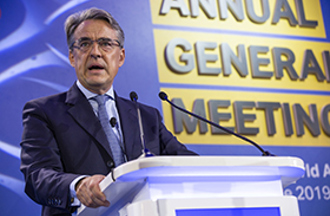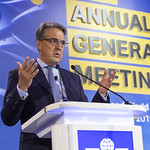
The Two hundred thousand (1). That is the number of people who will arrive safely by air at their destination before I complete this report.
Some will be reuniting with friends and family. Others will be on journeys of discovery, rejuvenation or learning. Still more will be on business—exploring markets or closing deals. A few will be starting a new life in a new land. And some will be travelling to solve political crises, share ideas or deliver help to those in need.
Flying generates infinite possibilities that enrich our society. Because of the hard work of the leaders in this room—and the 2.7 million airline employees (2) who stand behind them—the world of 2019 is more connected than ever.
Flying is freedom!
And we can be proud that it is our business. Flying contributes to 15 of the 17 UN Sustainable Development Goals (3). And two recent events underscored how valued aviation is:
- In January, the longest government shutdown in US history ended when it appeared that air traffic controllers were not going to report for work (4), and
- In March the UK and the European Union agreed that international air services would continue uninterrupted, irrespective of what kind of Brexit finally unfolds (5).
Unfortunately, creeping protectionist or isolationist political agendas are on the rise. And they threaten to compromise the value our industry creates. For aviation to be a catalyst of prosperity, borders must be open to people and to trade.
Aviation enables globalization. Since 1990, on average, globalization has lifted 130,000 (6) people a day from poverty. The more people connect through flying, the greater the benefits to all the people of this world.
That’s an important message for governments to hear.
Financial State
Solid financials are also needed for aviation to deliver its best.
As an industry, airlines have been in the black since 2010 (7). And since 2015 (8), returns to shareholders have exceeded their aggregate cost of capital.
The performance is not uniform. Some regions continue to struggle. But our sustained normal financial performance is a major shift from the boom and mostly bust cycles of the past.
2019 will see airlines make a $28 billion profit (9)— that’s $6.12 (10) per passenger. It’s a solid profit under challenging conditions. Passenger demand is robust. But trade wars and protectionist measures are taking their toll on the cargo business. And rising costs for fuel, labor and infrastructure are squeezing margins.
Returns will still exceed the cost of capital, but only just. And the industry’s 3.2% (11) net margin is modest and fragile compared to the margins of 20% (12) or more that Apple and Google regularly enjoy.
Looking to the future, the outlook is optimistic. Demand is forecast to double over the next two decades. With the cost of travel 40% (13) lower than a decade ago, the freedom to fly is reaching more people than ever. Aviation today is far from being an industry for the rich. The developing markets are expected to provide the majority of additional passenger demand. India and China alone are forecast to account for around 45% (14) of all additional passenger trips over the next two decades. Even more than today, the travelers of the future will come from all walks of life and economic means.
Meeting Demand
Meeting the demands of the future will test our industry’s capabilities.
- We need a solid platform to spread the benefits of aviation with efficient infrastructure and a diverse workforce,
- We need the capability to meet customer expectations with modern global-standard processes,
- And we must earn our license to grow with safety and sustainability.
These issues need action today to be ready for the future.
And, as an industry built on global standards, that action must be coordinated among stakeholders and across geographies.
Infrastructure
Let’s start with infrastructure—the physical platform to spread aviation’s benefits. Our requirements for airport and air traffic management are not complicated:
- Sufficient capacity
- Quality and efficiency aligned with airline expectations, and
- Affordable costs
We are far from that today.
European air traffic management shortcomings illustrate the problem. In 2018 aircraft flying in Europe experienced 19.1 million (15) minutes of en-route delays. That’s 36 years of wasted time that unnecessarily added 5.6% to our European carbon footprint. The prime causes are inadequate capacity and staff rostering. These are fixable. And that makes poor performance all the more disappointing.
Unfortunately, this is not an isolated example. Air traffic bottlenecks are found in China, the US, the Gulf and elsewhere.
On the airport side, Mexico City (16) is the poster child for deficiencies. We were midway through the construction of a solution for the city’s infamously congested airport. Then the newly-elected government pulled the plug with no viable alternative.
Critically congested airports are spread the world over. Sao Paolo, New York, London, Amsterdam, Mumbai, Bangkok and Sydney are all examples of airport bottlenecks due to capacity constraints—both real and artificial.
There is some good news. Some governments do understand the importance of infrastructure:
- Istanbul opened a major new hub earlier in the year and Beijing will soon follow.
- Poland (17), Italy (18) and France (19) have published national airspace strategies.
- And the Republic of Korea demonstrates what implementing an ambitious vision for connectivity can achieve. This country moved from poverty to the world’s 11th largest economy in a few decades. Strong transport links supported a successful export-led strategy. Incheon Airport is part of that success—famous for customer centricity, efficiency and affordability.
- The first demonstrates our commitment to Radio Frequency Identification (RFID) (30) for baggage. RFID has the potential to reduce mishandling—already rare—by a quarter. And when things do go wrong, we will know where the bag is. It’s what passengers expect.
- The other supports One ID (31) — a single biometric token that will reduce the hassles of identifying yourself as you move through the airport. This will boost efficiency from check-in to boarding—to the benefit of passengers, airports and the control authorities. To make this happen we must work with governments to agree global standards, harmonize approaches, sort out privacy issues, integrate with existing infrastructure and agree the implementation process.
- In 2018 there was one major accident for every 5.4 million flights (33).
- The 430 IOSA (34) - registered carriers outperformed non-IOSA carriers on safety by a factor of two (35).
- And over the last decade the fatal accident rate has improved by 59% (36).
- The environmental impact of an individual traveler has been cut in half compared to 1990 (39).
- CORSIA (40) — the Carbon Offsetting and Reduction Scheme for International Aviation — will facilitate carbon-neutral growth from 2020.
- And by 2050 (41) we will cut our net emissions to half 2005 levels—irrespective of growth—aligning ourselves with the goal of the Paris agreement.
- This is a great story in progress. How will we reach its very ambitious end?
- Modernizing air traffic management (42) could cut fuel burn if governments make investments to eliminate inefficiencies.
- Electric propulsion has potential. But even the most optimistic don’t see this playing a role outside of some regional flying in the near future.
- Which delivers real reductions,
- Will generate $40 billion (47) in climate financing by 2035, and
- Was agreed by governments to be the single global market-based measure.
- We must commit to make flying unquestionably sustainable.
- We must build the infrastructure capable of accommodating a further democratization of sustainable flying.
- We must ensure that our industry places no barriers in front of anyone seeking to make a career in aviation.
- We must evolve the processes to improve the convenience, accessibility and efficiency of flying.
- And we must do everything possible to keep flying safe and public confidence strong.
Footnotes
1. Total passenger figures (December 2018)
2. Aviation Benefits site
3. UN sustainable development goals
4. CNN
5. EASA
6. Based on The World Bank Taking on Inequality 2018 edition
7. IATA Economics report (pdf)
8. IATA Economics report (pdf
9. IATA Economics report (pdf
10. IATA Economics report (pdf
11. IATA Economics report (pdf
12. Macrotrends and Ycharts
13. IATA Economics report
14. IATA press release
15. Eurocontrol
16. IATA Press release
17. IATA Press release
18. IATA Press release
19. IATA Press release
20. IATA Press release
21. Eurocontrol
22. ACI
23. Resolution release
24. ATAG - Aviation – Benefits Beyond Borders Report 2018
25. IATA press release
26. IATA press release
27. www.iata.org/ndc
28. www.iata.org/oneorder
29. IATA press release
30. www.iata.org/rfid
31. www.iata.org/oneid
32. IATA press release
33. IATA press release
34. www.iata.org/iosa
35. IATA safety fact sheet (pdf)
36. Comparing 2018 with 2009 (10 years), the fatal accident rate (per million sectors) decreased by 59%
(0.24 in 2018 vs 0.59 in 2009). Source: GADM: www.iata.org/gadm
37. Bloomberg
38. Reuters
39. IATA World Air Transport Statistics
40. www.iata.org/corsia
41. IATA CORSIA fact sheet (pdf)
42. IATA Air Traffic page
43. IATA Technology Roadmap
44. IATA Alternative Fuels fact sheet (pdf)
45. IATA Alternative Fuels fact sheet (pdf)
46. Flight Global
47. www.iata.org/corsia
48. UN Climate Change report
49. IATA resolution press release

